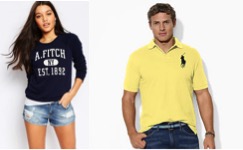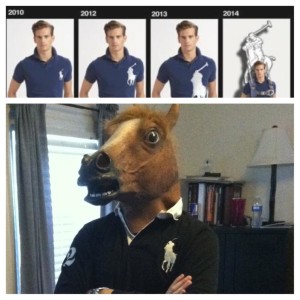Millennials are disrupting the way consumer shop. Retailing 101 shows that brand logos are an effective way to integrate marketing communication while advertising the brand. Retailers such as Ralph Lauren and Abercrombie and Fitch have built an empire in advertising their logo. To wear their logo meant that you were “in” and that you belong to certain class of consumers. To a company, brand logo symbolizes the company’s DNA, status and represents the lifeblood of the brand. Brands logos adds value to the brand and create brand equity (Keegan & Green, 2012). Trying to belong to a class group is not new. A study conducted by Guven and Sorensen shows that “perceived social class is highly correlated with happiness while actual social class is of little importance” (2012). With this information, retailers appeal to the emotional senses of “wanting” to fit in. They are selling a dream, a lifestyle and the opportunity to belong.
When you wear a brand’s logo, you are telling everyone that you are hip, belong to a certain class, and embody what the brand stands for. This was the guiding principle many brands leveraged in the 90’s and 2000’s. Brands were making their logo bigger, brighter and putting in on everything! Although a satirical view of brand logo evolution, the photo below gradually shows how ridiculously big the logos were getting! The brand logo in apparel and accessories were the early iterations of the #hashtag!
Now that millennials making up a bigger portion of the consumer spend, and since brand logos are no longer en vogue, many companies that were built on logos are suffering. A report conducted by Goldman Sachs indicated that millennial prefer clothing without labels. With consumer preference changing, many brands have minimized the presence of their logo and many have opted to get rid of their logo altogether. Without the logos, many companies have become unrecognizable. Since most brands offer similar styles, without their logos there are no differentiating factors that distinguish one brand to the other. This, coupled with millennial discretionary shopping habits changing, many companies have lost millions.
Earlier generations derived status from what they bough or wore, but millennials are after experiences rather than material goods. With this disruption in consumer spending and different shopping patterns, what are retailers doing? For one, many brands have increased their social media presence. With the increase in social media, retailers are hoping to increase social marketing and gain leverage power of social and mobile marketing to attract millennials. Second, retailers are increasing their social corporate responsibility (SCR) to attract millennials. A study by Stanford, has shown that companies that have increased their SCR, have increased in profit. Retailers know that millennials care about causes important to them, so retailers are slowly shifting focus to their philanthropy work.
The road ahead looks grim for some retailers. Millennials would rather spend their money one nice dinners, experiences and more tangible items than clothes, causing many retailers to shift their offerings to non-branded goods. Many retailers like Kate Spade, now offer practicality and function over brand names. Kate Spade has started to shift their focus to craftsmanship – a trait that millennials favor. So if retailers want to survive and attract millennials, they will need offer an assortment that compliments their values, goals and aspirations.
References
Guven, C. & Sørensen, B.E. (2012). Subjective well-being: keeping up with the Joneses. Real or perceived? 109: 439. doi:10.1007/s11205-011-9910-x
Keegan, W. J. & Green, M. C. (2016). Global marketing (9th ed.). New Jersey: Prentice Hall.
Nelson, M.E., (2012). Millenials want to party with your brand but on their own terms. Advertising Age. Retrieved from http://adage.com/article/digitalnext/millennials-party-brand-terms/236444/



13 Responses to Where have the brand logos gone?